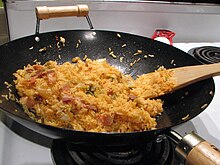Kimchi fried rice: Difference between revisions
m Bot: Migrating 5 interwiki links, now provided by Wikidata on d:q712554 (Report Errors) |
removed Category:South Korean cuisine using HotCat |
||
| Line 48: | Line 48: | ||
[[Category:Kimchi]] |
[[Category:Kimchi]] |
||
[[Category:Rice dishes]] |
[[Category:Rice dishes]] |
||
[[Category:South Korean cuisine]] |
|||
Revision as of 13:44, 8 March 2013
| Kimchi fried rice | |
 | |
| Korean name | |
|---|---|
| Hangul | 김치 볶음밥 |
| Revised Romanization | gimchi bokkeumbap |
| McCune–Reischauer | kimch'i pokkŭmpap |
 |
| This article is part of a series on |
| Korean cuisine 한국 요리 조선 료리 |
|---|
Kimchi bokkeumbap (Korean pronunciation: [kimtɕʰi bok͈ɯmbap]) is a variety of bokkeumbap (Hangul: 볶음밥, fried rice dishes), a popular dish in South Korea.[1] Its name literally translates as "Kimchi fried rice". Kimchi bokkeumbap is made primarily with kimchi and rice, along with other available ingredients such as diced vegetables or meats.[1]
Ingredients
Leftover rice and/or over-ripened kimchi as ingredients are usually preferred in preparing kimchi bokkeumbap.[2] Over-ripened kimchi can also be used for cooking kimchi jjigae.[1] Indeed, well-fermented kimchi and chilled rice can produce a flavor of greater richness as opposed to freshly made kimchi and rice.[2] In preliminary preparation, as surplus "kimchiso" (hangul: 김치소, kimchi filling, mostly shredded daikon, green onions and jeotgal, fermented and salted seafood) taken out from kimchi, squeezed to discard its brine. Without completing the process, the resultant dish can be mushy in texture.
Along with kimchi and rice, kimchi bokkeumbap can contain many kinds of ingredients.[2] Pork or spam are the most common, however, beef, chicken, bacon, or ham can be used. Instead of meat, canned tuna, shrimp, or mushrooms can be used as a replacement, in the case the ingredient's name may be prefixed to the dish's name such as "beoseot kimchi bokkeumbap" (hangul: 버섯김치볶음밥, literally "mushroom kimchi bokkeumbap"). Meat ingredients are chopped into the dish together with vegetables such as onion, carrot or zucchini. However, ingredients depend on personal preference and occasion. A small amount of minced garlic and sliced green pepper can be used as seasoning. These ingredients are fried in a pan with a little vegetable or sesame oil.
After the cooked dish is put on a plate or in a bowl, a fried egg is sometimes served on top.[2] Thinly shredded gim, chopped scallions or sesame are spread over it to enhance the flavor and to garnish.
Popularity
Since kimchi bokkeumbap is cheap and easy to make in a short period of time, it is favored by students living alone who can not afford expensive meals.[2] Kimchi bokkeumbap is also a popular item for lunch at a bunsikjeom (hangul: 분식점, a diner or bistro-like restaurant in South Korea). As the dish is hot and spicy, it is typically served with danmuji and a small bowl of any kind of mild and warm soup such as miyeok guk (soup made with wakame),[3] or kongnamul guk (hangul: 콩나물국, "kongnamul soup, or bean sprout soup"). During summer, cool dongchimi (water kimchi) can also be accompanied with the dish.
The popularity of kimchi bokkeumbap is also reflected in South Korean pop culture. Byeon Jin-sub (hangul: 변진섭), a popular male singer in the late 1980s, sang a song titled "Wishes" (hangul: 희망사항) in which he stated that the singer's ideal girlfriend would be one who cooks good kimchi bokkeumbap. In the song "I Need A Girl" by Taeyang, he also says that his ideal girlfriend will eat the kimchi bokkeumbap that he cooks.[2][4]
See also
References
- ^ a b c "Kimchi Fried Rice". TriFood.com. Retrieved 2008-04-02.
- ^ a b c d e f "Korean Food: Stir-fried Dishes". Life in Korea, Inc. Retrieved 2008-04-02.
- ^ DCC, Elizabeth Lim. "Kimchi Fried Rice". mealsmatter.org.
- ^ Choi, Yeong-jin (최영진) (February 2006). "새해를 다이어트 콘서트로 시작하는 변진섭& 아내 이주영" (in Korean). Kyonghyang Sinmun. Retrieved 2008-04-02.
{{cite journal}}: Cite journal requires|journal=(help)
